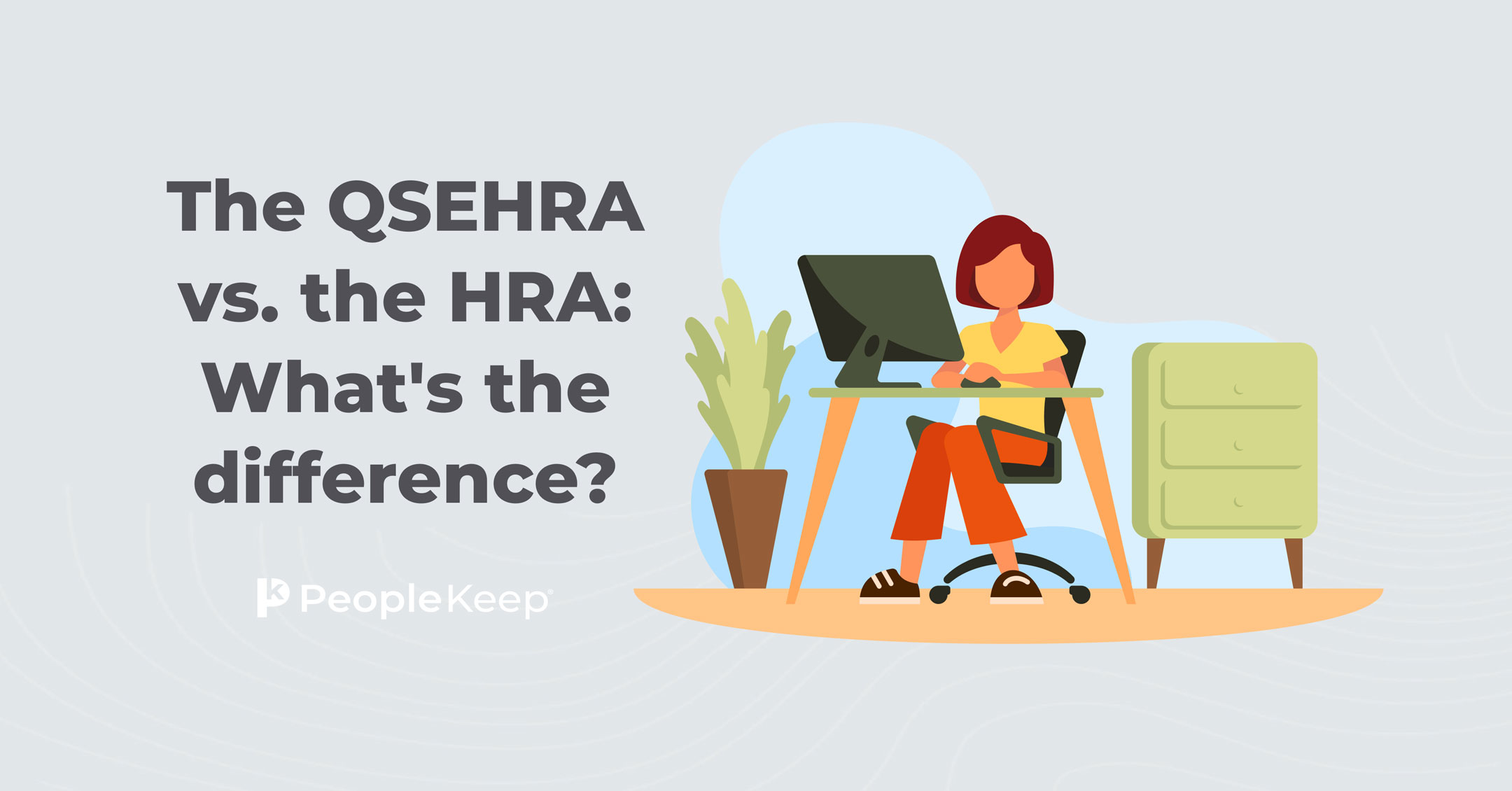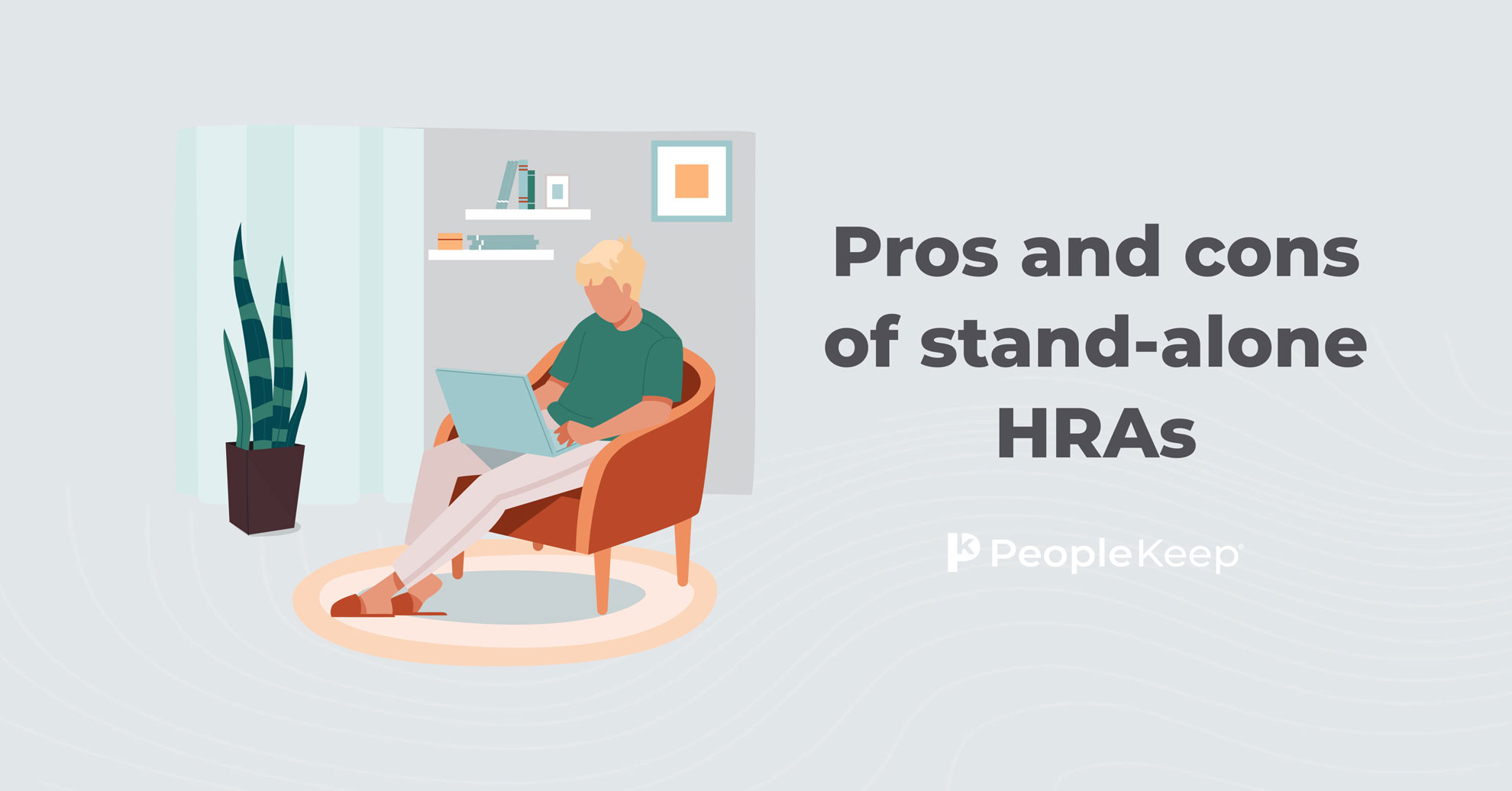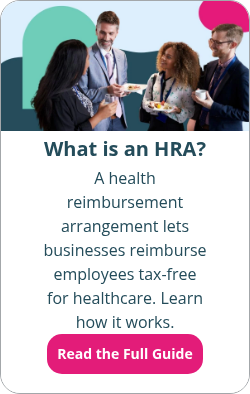Myths about health reimbursement arrangements (HRAs)
By Elizabeth Walker on March 29, 2024 at 10:00 AM
If you’re an employer offering a health benefit for the first time, you may be deciding between traditional group health insurance and a healthcare reimbursement plan, like a health reimbursement arrangement (HRA).
Despite the increasing popularity of HRAs, which offer greater personalization, cost savings, and tax advantages, you may be hesitant to offer one due to common misconceptions.
In this article, we’ll debunk common HRA myths to help you better understand how an HRA can be an affordable and flexible health benefit for you and your employees.
Takeaways from this blog post:
- An HRA is an IRS-approved, formal health benefit that employers can leverage as a more flexible and affordable alternative to group health plans.
- Employers can use HRAs to reimburse employees for various healthcare expenses that the employee chooses, like monthly premiums, vision and dental costs, and prescription drugs.
- HRA contributions and reimbursements are payroll tax-free for employers. Reimbursements are also free of income taxes for employees as long as their health plan provides minimum essential coverage (MEC).
What is an HRA?
The best way to avoid falling for HRA myths is to understand how they work. Let’s briefly review them. An HRA is an IRS-approved tax-free health benefit employers use to reimburse eligible employees for qualifying out-of-pocket expenses and, in some cases, individual health insurance plan premiums.
The way HRAs work is simple. You offer your current employees a monthly allowance they can use on healthcare, like prescription drugs, over-the-counter medicine, doctor visits, and more. Once an employee makes an approved purchase, you reimburse them tax-free up to their allowance amount.
An HRA is an employer-funded benefit, meaning employees can’t contribute. They’re also employer-owned. This means that any unused amounts stay with the employer if an employee leaves your company, unlike what happens with funds in health savings accounts (HSAs).
HRAs are a budget-friendly way for employers of all sizes to offer their employees a well-rounded health benefit that can meet every individual’s needs. Better yet, their flexibility and customizability are excellent ways to attract and retain talented employees in a competitive labor market.
Now that we’ve reviewed how HRAs work let’s dive into some myths you may have heard about them.
Myth 1: HRAs don’t qualify as a real health benefit
Some employers think that because they haven’t heard of an HRA, it must not be a formal health benefit, but this couldn’t be further from the truth. As mentioned above, an HRA is an IRS-approved, employer-funded health plan where current employees can receive reimbursement for qualified medical expenses.
Instead of a traditional group health plan, employers can offer a qualified small employer HRA (QSEHRA) or an individual coverage HRA (ICHRA). With these two stand-alone HRAs, employees choose the individual health insurance policy that works best for them. Then, you reimburse them for their individual health insurance premiums and other medical expenses.
The IRS sets an annual maximum contribution limit for QSEHRAs. However, an ICHRA has no minimum or maximum contribution limit.
The IRS regulates the tax treatment of HRAs, but does the federal government actually allow them? Yes. Congress established the QSEHRA as part of the 21st Century Cures Act, while the Departments of the Treasury, Labor, and Health and Human Services established the ICHRA following an executive order.
Stand-alone HRAs aren’t your only option. With a group coverage HRA (GCHRA), also called an integrated HRA, employers can supplement their group health plan to help employees pay their deductibles, copays, and other out-of-pocket costs. Only employees who enroll in your group plan can participate in the benefit. Like ICHRAs, GCHRAs have no annual limits. But, the federal government doesn’t allow reimbursements for group health plan premiums.
As with other formal health benefits, you must follow IRS regulations to ensure your HRA remains compliant. Some rules, like contribution limits, change annually, while others, like reporting requirements, typically stay the same. In either case, it’s crucial to stay up to date on all federal regulations regarding HRAs to ensure you avoid any fines.
Learn the basics of compliance requirements in our complete guide
Myth 2: HRAs cost more than traditional group insurance
Offering traditional group benefits can be challenging for some employers due to their unpredictable health costs. Luckily, HRAs are a cost-effective way to offer health benefits to employees, providing more value for less money than group health insurance.
By offering a QSEHRA or an ICHRA, employers can avoid purchasing a group health plan altogether. Considering that the average annual premium for group health insurance in 2023 was $8,435 for self-only coverage and $23,968 for family coverage, this can save businesses with limited benefits budgets a tremendous amount of money1. Instead, you’ll only be responsible for reimbursing your employees for approved medical expenses.
Individual health insurance costs are less expensive than small group health insurance in many states, making premium reimbursement a no-brainer in those places.
Look at the potential savings2 of reimbursing employees for individual health insurance premiums in select counties below:
|
County |
27-year-old |
50-year-old |
||
|
Monthly small group premium |
Monthly individual silver premium |
Monthly small group premium |
Monthly individual silver premium |
|
|
Pierce County, WA |
$330 |
$310 |
$563 |
$529 |
|
Denver County, CO |
$332 |
$269 |
$566 |
$459 |
|
Cuyahoga County, OH |
$520 |
$326 |
$887 |
$556 |
|
Fulton County, GA |
$420 |
$335 |
$716 |
$571 |
|
Duval County, FL |
$411 |
$276 |
$701 |
$470 |
However, an HRA can help organizations save money no matter where they’re located.
That’s because HRAs also have a fixed cost—unlike group health plans, which often have annual rate hikes. When designing your HRA benefit, you pick a monthly allowance that best suits your budget. Once you determine your allowance, employees can’t exceed it. Plus, any unused amounts stay with you, so you only reimburse what your employees use.
Myth 3: HRAs won’t satisfy the ACA’s employer mandate
The Affordable Care Act’s (ACA) employer mandate requires applicable large employers (ALEs) to offer at least 95% of their full-time employees and their dependents health insurance that’s affordable and meets minimum essential coverage (MEC). If they don’t, they may be subject to costly penalties under the employer shared responsibility provisions (ESRP).
Many employers assume traditional group health plans are the only form of health insurance that satisfies this mandate, but this isn’t the case. The ICHRA can fulfill the employer mandate requirements for large employers as long as the IRS considers your employees’ allowances affordable.
Whether or not your ICHRA is affordable depends on how you design your benefit. In 2026, an ICHRA is affordable as long as it doesn't require any of your employees to pay more than 9.96% of their annual household income for health insurance.
In your calculations, use the cost of the lowest-cost individual silver plan to determine how much of an allowance you need to provide to ensure your ICHRA is affordable. If you need help determining affordability, the federal government allows employers who offer an ICHRA to use safe harbors.
Employees with an ICHRA must also ensure their individual health insurance policy meets minimum value. There are several ways they can do this. For example, they can buy family or self-only coverage from a public or private exchange or a Medicare plan if eligible.
If your ICHRA is affordable and your employees have a qualified health plan with minimum value, your benefit will satisfy the employer mandate, keeping you safe from penalties.
Myth 4: An HRA won’t cover the healthcare services that employees need
From Aspirin to mental health counseling to x-rays and physical checkups, what an HRA can reimburse can be surprising to some. IRS Publication 5023 and the CARES Act4 list more than 200 eligible expenses for reimbursement under an HRA. So, it’s likely that every employee will be able to cover the healthcare costs they need.
According to our 2024 QSEHRA Report, 42% of all reimbursements in 2023 were for premiums. The remaining 58% of reimbursements were for other out-of-pocket medical expenses, like vision and dental costs, therapy, over-the-counter medications, and more. These numbers justify that HRAs are flexible enough to meet your employees’ needs, whether it’s just covering health insurance premiums or other eligible expenses.
After incurring a qualified expense, employees must submit proof of purchase, usually as an invoice or receipt. For some expenses, like dietary supplements or massage therapy, the IRS requires employees to submit a doctor’s note or prescription to prove medical necessity to receive reimbursement. Once you verify the expense, you can reimburse the employee up to their allowance amount.
There’s a wide range of benefits HRAs can provide your employees. However, it’s essential to communicate the eligible expenses and what documentation they need to provide to receive reimbursements to ensure they get the most out of their HRA.
Myth 5: HRA expense reimbursements are subject to taxes
One of the biggest questions employers ask is if HRAs are taxable. Unlike some qualified health plans, HRA funds aren’t subject to federal or state income taxes. As long as your HRA complies with all IRS regulations, contributions and reimbursements are also payroll tax-free for employers.
To receive all your tax benefits, your HRA must meet specific requirements, such as being 100% employer-funded and following reporting regulations. You must also have formal plan documents describing how you’ll manage the HRA, what medical expenses are reimbursable, eligibility requirements, effective dates, and more to comply with federal guidelines.
Lastly, HRA reimbursements are also income tax-free for employees as long as their health plan provides MEC. Employer-sponsored group health plans, individual health plans purchased on a public or private exchange, and government-sponsored program plans, like Medicare or Medicaid, typically provide MEC.
Learn more about how taxes work with an HRA in our article
Myth 6: HRAs don’t promote health equity
With an ICHRA, you can offer different allowance amounts to different employee classes. For example, you can offer your full-time employees a higher allowance than your part-time employees and seasonal workers. You can also vary allowances based on age and family size. While employers see this capability as a welcome customization, some may believe it encourages discrimination in the workplace. But this isn’t the case.
With an ICHRA, your employees can choose the individual health insurance policy that works best for them instead of forcing them into a group plan they may not like. They can even decide not to participate in the benefit if they don’t feel it’s right for their needs, such as if they want to take advantage of their premium tax credits.
Another common misconception is that ICHRAs encourage employers to push older employees onto the individual ACA marketplaces, driving up costs for those plans while younger employees get group coverage. This isn’t true. The HRA Council’s 2023 Growth Trends for ICHRA and QSEHRA Report5, to which PeopleKeep contributed data, shows that the average age of ICHRA participants is 44. Federal law also prohibits employers from using an ICHRA to discriminate against employees based on age or health status.
ICHRAs aren’t the only HRA that features class customization. A GCHRA also allows employers to differ allowances and eligibility based on seven classes. Employees participating in a GCHRA must have traditional employer-sponsored coverage to participate, no matter their class. But, your allowance allows them to receive reimbursements for the medical services and items they want.
Customizing your ICHRA or GCHRA based on employee classes is an option, but there’s no requirement to do it. If you want to assign every employee the same allowance amount—regardless of job position, location, age, or family status—you can do so. This way, you can guarantee all active employees an equitable and affordable health benefit.
Conclusion
Implementing any new health benefit can be a burdensome task at first. But while there are many misconceptions about HRAs, don’t always believe what you hear. You can leverage an HRA to receive tax benefits, control your budget, and help your employees and their families offset their medical expenses. And because HRAs are customizable to suit the needs of the employer and the employees, they’re one of the most flexible health benefits available today.
This blog article was originally published on January 12, 2022. It was last updated on March 29, 2024.
1. https://www.kff.org/report-section/ehbs-2023-summary-of-findings/
2. http://analytics.ideonapi.com/veristat/hra/lowest-premiums-map/2024/
3. https://www.irs.gov/pub/irs-pdf/p502.pdf
4. IRS outlines changes to healthcare spending under CARES Act
5. https://hracouncil.wildapricot.org/resources/Documents/2023_HRAC_DataProject_Final_Revised_v2.pdf
Check out more resources
See these related articles

The QSEHRA vs. the HRA: What's the difference?
Confused about the difference between an HRA and a QSEHRA? This guide explains how a QSEHRA compares to other types of HRAs.

HRAs and W-2 annual reporting
Learn about HRA W-2 annual reporting requirements. Understand what employers need to include on employees' W-2 forms for HRA compliance.

Pros and cons of stand-alone HRAs
Stand-alone HRAs can offer flexibility and control over healthcare expenses, allowing employers to customize plans to meet their employees' needs.



